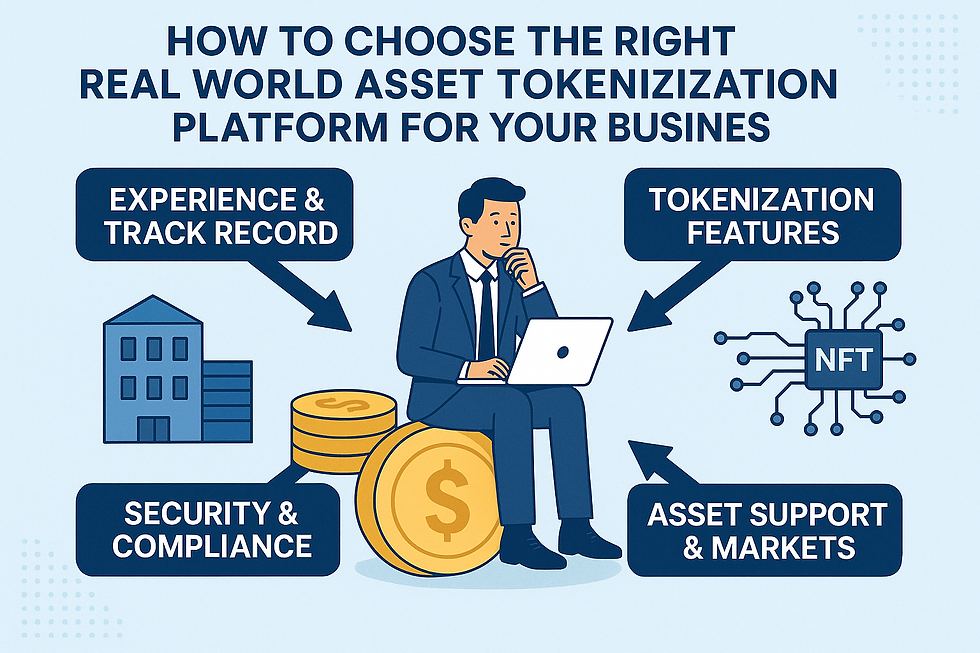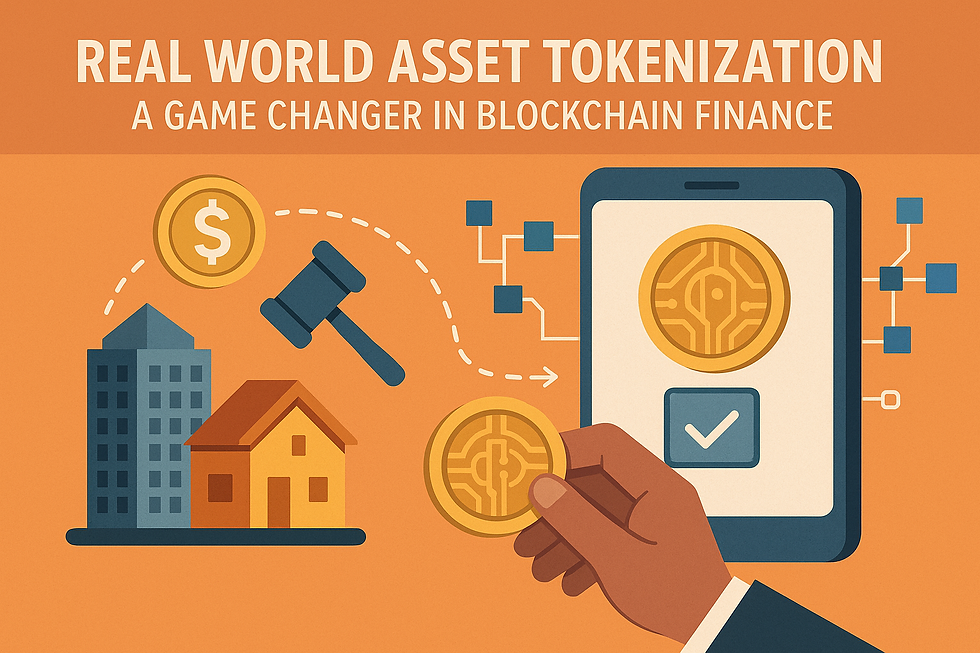Start Real World Asset Tokenization With Minimal Cost
- steveganger
- Jul 10
- 4 min read
In today's evolving digital economy, Real World Asset Tokenization has emerged as a groundbreaking innovation. It allows individuals and institutions to digitize tangible assets like real estate, gold, art, and more into blockchain-based tokens. These tokens are secure, traceable, and tradable—offering unmatched transparency and liquidity.
But the best part? You can start Real World Asset Tokenization with minimal cost.
Whether you’re a startup founder, investor, or asset owner, understanding how Real World Asset Tokenization works and how to get started affordably is key to future-proofing your wealth strategy.
What Is Real World Asset Tokenization?
Real World Asset Tokenization is the process of converting physical, off-chain assets into digital
tokens using blockchain technology. These tokens represent ownership or shares of the asset and can be traded on digital platforms.
By implementing Real World Asset Tokenization, organizations can:
Improve liquidity
Increase transparency
Enable fractional ownership
Reduce fraud and operational inefficiencies
Imagine owning 0.1% of a luxury hotel or a piece of fine art. That’s what Real World Asset Tokenization enables.
Why Choose Real World Asset Tokenization?
Low Entry Barriers: With modern blockchain platforms, Real World Asset Tokenization no longer requires massive capital investments. The infrastructure is becoming more user-friendly and affordable.
Global Accessibility:Tokenized assets can be accessed and traded globally, giving investors exposure to previously inaccessible markets.
24/7 Markets:Unlike traditional financial markets, Real World Asset Tokenization offers around-the-clock trading opportunities.
Cost Efficiency:By removing middlemen like brokers, the Real World Asset Tokenization model significantly reduces costs, making transactions more efficient and cheaper.
How to Start Real World Asset Tokenization on a Budget
1. Choose the Right Blockchain Platform
Start by selecting a reliable blockchain that supports tokenization. Ethereum, Polygon, and Binance Smart Chain are popular choices for Real World Asset Tokenization due to their security and smart contract capabilities.
Look for platforms that offer:
Low gas fees
User-friendly interfaces
Strong developer support
This helps reduce your upfront costs while ensuring scalability.
2. Work with a Tokenization Service Provider
Partner with a firm that specializes in Real World Asset Tokenization. Many providers offer cost-effective, end-to-end solutions that include:
Legal compliance
Smart contract development
Token issuance
Marketplace integration
Choose providers who focus on minimal-cost entry strategies.
3. Select the Right Asset
Not all assets are ideal for tokenization. Focus on:
Real estate
Precious metals
Artwork
Commodities
Revenue-generating contracts
The more valuable and traceable the asset, the more effective your Real World Asset Tokenization strategy will be.
4. Legal Compliance
Legal compliance is critical in Real World Asset Tokenization. Ensure your tokenized assets are in line with local and international regulations, especially regarding securities and anti-money laundering (AML) laws.
Use templates and pre-audited contracts offered by tokenization platforms to save legal costs.
5. Launch & Market
Once your tokens are live, promote them using:
Crypto-focused platforms
NFT marketplaces (if applicable)
Crowdfunding sites
Social media and content marketing
Educational content about Real World Asset Tokenization helps build trust and attract investors.
Use Cases of Real World Asset Tokenization
Real Estate
By far the most popular sector for Real World Asset Tokenization, real estate can now be divided into digital shares. A $1 million property can be divided into 1 million tokens worth $1 each, allowing micro-investments.
Art & Collectibles
High-value art pieces or rare collectibles can be tokenized and sold in fractions. This democratizes access to luxury assets and creates new investment opportunities.
Commodities
Gold, oil, and even agricultural products can be tokenized using smart contracts. This makes Real World Asset Tokenization a valuable tool for commodity trading firms and investors.
Debt Instruments
Tokenizing bonds or invoices allows companies to raise capital efficiently. Investors receive dividends or interest directly via smart contracts—another benefit of Real World Asset Tokenization.
Myths Around Real World Asset Tokenization
“It’s Only for Big Companies”
False. Small businesses and even individuals are adopting Real World Asset Tokenization thanks to affordable platforms and simplified processes.
“It’s Too Technical”
Modern no-code and low-code solutions make Real World Asset Tokenization accessible to non-tech users.
“It’s Illegal”
When done in compliance with local regulations, Real World Asset Tokenization is not only legal but encouraged in many jurisdictions.
Real World Asset Tokenization vs. Traditional Asset Management
Feature | Traditional Assets | Real World Asset Tokenization |
Liquidity | Low | High |
Accessibility | Limited | Global |
Transaction Speed | Days | Minutes |
Entry Cost | High | Minimal |
Transparency | Low | High (via Blockchain) |
Future of Real World Asset Tokenization
The World Economic Forum estimates that 10% of global GDP will be stored on blockchain by 2030. A large portion of this will come from Real World Asset Tokenization.
As the world moves toward decentralized finance (DeFi), Real World Asset Tokenization will bridge the gap between physical assets and digital financial systems.
It’s expected that:
Tokenized real estate will become the norm
Art ownership will be fractional
Capital raising through tokenized debt will explode
Final Thoughts
Real World Asset Tokenization is no longer a futuristic concept—it’s happening now. And the best news? You don’t need a massive budget to participate. Thanks to streamlined platforms, compliance tools, and automation, anyone can start Real World Asset Tokenization with minimal cost.
Whether you’re an entrepreneur, an investor, or a tech innovator, this is your chance to ride the next big wave in digital finance.






Comments